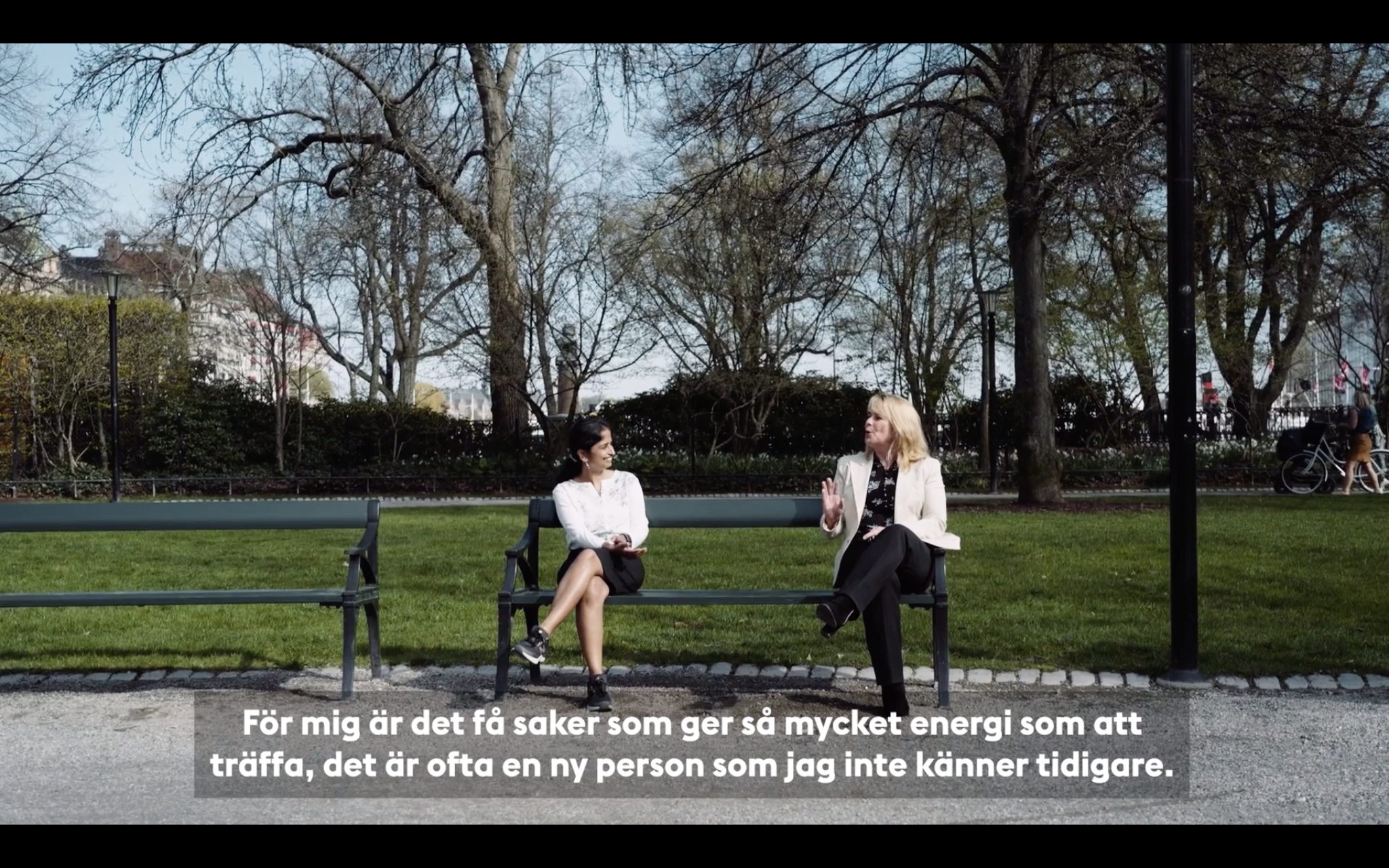

The Stockholmsmentor program: Connecting expats with the Swedish job market
The Stockholmsmentor program: Connecting expats with the Swedish job market
By Anirban Dey
Skills mismatch in the Swedish job market
Newcomers to Stockholm usually find it difficult to get a foothold in the Swedish job market.
The educational backgrounds and professional competences of highly skilled immigrants are often not tapped into, which means that they either find low-paying jobs that under-utilize their qualifications, or even end up unemployed in the long-term.
This seemingly inexplicable trend has existed for decades, despite there being a long-standing labor shortage across various fields in the Swedish job market (such as IT, healthcare, education, etc.).
This is because expats lack the required network and connections to make inroads into workplaces. They also do not have the essential know-how of the way the job market works in Stockholm, or the professional avenues that can be explored.
The Stockholmsmentor program
Stockholmsmentor – a mentorship program run by the City of Stockholm in conjunction with over 300 organizations (with Nema Problema acting as a conduit between the different stakeholders) as part of the Integration Pact – seeks to close this gap.
The 8-month-long program brings together established members of the Swedish business community as ‘mentors’ to newly arrived immigrants (‘mentees’) from similar fields of expertise.
Over monthly meetings with the mentees, the mentors share their knowledge of the Swedish job market, their contacts at organizations, and their insights into building a career path that matches the mentees’ skills with a perfect job.
Swetha Dua (Project Manager at Avanade) – an SDCN member and a former mentee in the Stockholmsmentor program visibly beams when she talks about how the program benefitted her, and how her mentor – Magdalena Gerger (CEO and President at Systembolaget) guided her along the way.
Relocating from Delhi to Stockholm in the heydays of COVID, Swetha’s initial attempts at job-hunting in the first six months did not yield positive results. She realized that she needed to get an in – ‘It’s crucial that you have local contacts here to get into the door – someone who can tell you the dos and don’ts. There are particular nuances to understanding Swedish business culture. Otherwise, you are just one of thousand applicants on LinkedIn.’
Magdalena echoes Swetha’s views about why a program like this is needed in the first place – ‘Programs like this are vital – both for us living in Stockholm already, and for those who would like to live here. This helps new arrivals learn quickly about Sweden and our culture, our language, the way things work here, the job market, etc. It’s also important for us Swedes to learn about the skills that international individuals bring to us, enriching our society and workplaces.’
Two things, Swetha identifies, started turning things around for her – ‘First was SDCN, followed by the Stockholmsmentor program. These gave me my first breakthrough – I had put in effort, but this is the route that helped me the most.’
Swetha met Ulrika Hällgren and Karin Bröms (co-ordinators of the Stockholmsmentor program) at an event hosted by SDCN. She was then selected for the program and soon met Magdalena at the orientation.
Swetha was pleasantly surprised by Magdalena’s promptness to get into gear – ‘She was really responsive and set the date for our first meeting within the next three days. I was happy that she showed interest and really wanted me to find a good opportunity through this program.’
The key to making the most out of the meetings with the mentor, Swetha stresses repeatedly, is to be well-prepared beforehand – ‘I sent Magdalena a short presentation about me before our first meeting, so she knows who I am, what my profile is, and what my journey has been till this point. I wanted her to know what actions I have taken so far, and what my challenges have been.’
Magdalena immediately advised Swetha to apply for a larger pool of companies (instead of the small group that she was applying to). Swetha made a list – in order of priority – of 30–40 companies where she potentially saw herself working. This way, an action plan was gradually chalked.
One of the important points on the action plan was applying at Jobbsprånget – a 4-month-long internship run by the Royal Swedish Academy of Engineering Sciences. It was during Swetha’s tenure at Jobbsprånget that she got an internship offer at Addressya. Magdalena was generous with her help in this process, even responding to an urgent mail from Swetha over the weekend. ‘I realized I was breaking protocol by contacting her (during the weekend), but I’m glad she understood my urgency,’ Swetha laughs.
It was finally the end of a long road for Swetha when her internship with Addressya led her to find a position with Avanade, where she presently works.
Doing one’s groundwork in advance and being an active participant in the program, making it a two-way process between the mentor and the mentee – is what Swetha thinks made the most difference.
Magdalena wishes her the best for the future – ‘I do hope Swetha gets nice Swedish friends here, and lives her life her with passion and success.’
 When the mentor and the mentee finally met! (Image courtesy: Stockholms stad)
When the mentor and the mentee finally met! (Image courtesy: Stockholms stad)
The opportunities ahead
With the labor deficit in certain market sectors expected to soar in the coming years, it can be reasonably assumed that both international and Swedish organizations will need to explore a diverse talent pool. Going forward, programs like Stockholmsmentor will not only be a crucial talent pipeline, but will also help expats understand the nature of the Swedish job market better, and ease their process of social/professional integration.
Anirban Dey is Writer/Communicator at Stockholm Academic Forum, and a member of the SDCN Management Team. He has written several articles about useful resources in Stockholm, so check out the ‘Latest from SDCN’ section of our website!
Last updated 2021/10/26
By Anirban Dey
Skills mismatch in the Swedish job market
Newcomers to Stockholm usually find it difficult to get a foothold in the Swedish job market.
The educational backgrounds and professional competences of highly skilled immigrants are often not tapped into, which means that they either find low-paying jobs that under-utilize their qualifications, or even end up unemployed in the long-term.
This seemingly inexplicable trend has existed for decades, despite there being a long-standing labor shortage across various fields in the Swedish job market (such as IT, healthcare, education, etc.).
This is because expats lack the required network and connections to make inroads into workplaces. They also do not have the essential know-how of the way the job market works in Stockholm, or the professional avenues that can be explored.
The Stockholmsmentor program
Stockholmsmentor – a mentorship program run by the City of Stockholm in conjunction with over 300 organizations (with Nema Problema acting as a conduit between the different stakeholders) as part of the Integration Pact – seeks to close this gap.
The 8-month-long program brings together established members of the Swedish business community as ‘mentors’ to newly arrived immigrants (‘mentees’) from similar fields of expertise.
Over monthly meetings with the mentees, the mentors share their knowledge of the Swedish job market, their contacts at organizations, and their insights into building a career path that matches the mentees’ skills with a perfect job.
Swetha Dua (Project Manager at Avanade) – an SDCN member and a former mentee in the Stockholmsmentor program visibly beams when she talks about how the program benefitted her, and how her mentor – Magdalena Gerger (CEO and President at Systembolaget) guided her along the way.
Relocating from Delhi to Stockholm in the heydays of COVID, Swetha’s initial attempts at job-hunting in the first six months did not yield positive results. She realized that she needed to get an in – ‘It’s crucial that you have local contacts here to get into the door – someone who can tell you the dos and don’ts. There are particular nuances to understanding Swedish business culture. Otherwise, you are just one of thousand applicants on LinkedIn.’
Magdalena echoes Swetha’s views about why a program like this is needed in the first place – ‘Programs like this are vital – both for us living in Stockholm already, and for those who would like to live here. This helps new arrivals learn quickly about Sweden and our culture, our language, the way things work here, the job market, etc. It’s also important for us Swedes to learn about the skills that international individuals bring to us, enriching our society and workplaces.’
Two things, Swetha identifies, started turning things around for her – ‘First was SDCN, followed by the Stockholmsmentor program. These gave me my first breakthrough – I had put in effort, but this is the route that helped me the most.’
Swetha met Ulrika Hällgren and Karin Bröms (co-ordinators of the Stockholmsmentor program) at an event hosted by SDCN. She was then selected for the program and soon met Magdalena at the orientation.
Swetha was pleasantly surprised by Magdalena’s promptness to get into gear – ‘She was really responsive and set the date for our first meeting within the next three days. I was happy that she showed interest and really wanted me to find a good opportunity through this program.’
The key to making the most out of the meetings with the mentor, Swetha stresses repeatedly, is to be well-prepared beforehand – ‘I sent Magdalena a short presentation about me before our first meeting, so she knows who I am, what my profile is, and what my journey has been till this point. I wanted her to know what actions I have taken so far, and what my challenges have been.’
Magdalena immediately advised Swetha to apply for a larger pool of companies (instead of the small group that she was applying to). Swetha made a list – in order of priority – of 30–40 companies where she potentially saw herself working. This way, an action plan was gradually chalked.
One of the important points on the action plan was applying at Jobbsprånget – a 4-month-long internship run by the Royal Swedish Academy of Engineering Sciences. It was during Swetha’s tenure at Jobbsprånget that she got an internship offer at Addressya. Magdalena was generous with her help in this process, even responding to an urgent mail from Swetha over the weekend. ‘I realized I was breaking protocol by contacting her (during the weekend), but I’m glad she understood my urgency,’ Swetha laughs.
It was finally the end of a long road for Swetha when her internship with Addressya led her to find a position with Avanade, where she presently works.
Doing one’s groundwork in advance and being an active participant in the program, making it a two-way process between the mentor and the mentee – is what Swetha thinks made the most difference.
Magdalena wishes her the best for the future – ‘I do hope Swetha gets nice Swedish friends here, and lives her life her with passion and success.’
 When the mentor and the mentee finally met! (Image courtesy: Stockholms stad)
When the mentor and the mentee finally met! (Image courtesy: Stockholms stad)
The opportunities ahead
With the labor deficit in certain market sectors expected to soar in the coming years, it can be reasonably assumed that both international and Swedish organizations will need to explore a diverse talent pool. Going forward, programs like Stockholmsmentor will not only be a crucial talent pipeline, but will also help expats understand the nature of the Swedish job market better, and ease their process of social/professional integration.
Anirban Dey is Writer/Communicator at Stockholm Academic Forum, and a member of the SDCN Management Team. He has written several articles about useful resources in Stockholm, so check out the ‘Latest from SDCN’ section of our website!
Last updated 2021/10/26
